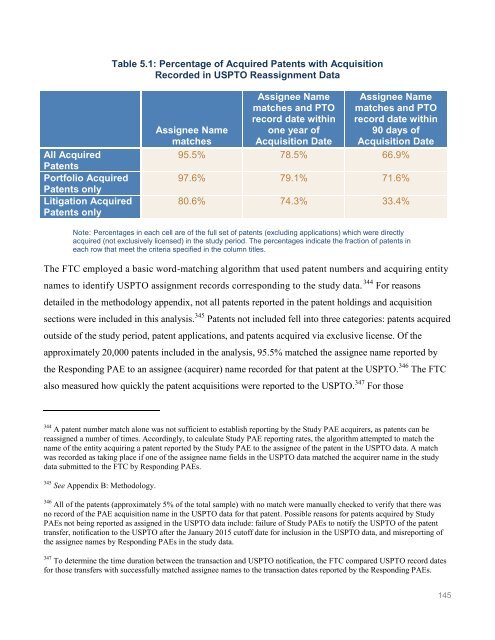You also want an ePaper? Increase the reach of your titles
YUMPU automatically turns print PDFs into web optimized ePapers that Google loves.
Table 5.1: Percentage of Acquired <strong>Patent</strong>s with Acquisition <br />
Recorded in USPTO Reassignment Data<br />
All Acquired<br />
<strong>Patent</strong>s<br />
Portfolio Acquired<br />
<strong>Patent</strong>s only<br />
Litigation Acquired<br />
<strong>Patent</strong>s only<br />
Assignee Name<br />
matches<br />
Assignee Name<br />
matches and PTO<br />
record date within<br />
one year of<br />
Acquisition Date<br />
Assignee Name<br />
matches and PTO<br />
record date within<br />
90 days of<br />
Acquisition Date<br />
95.5% 78.5% 66.9%<br />
97.6% 79.1% 71.6%<br />
80.6% 74.3% 33.4%<br />
Note: Percentages in each cell are of the full set of patents (excluding applications) which were directly<br />
acquired (not exclusively licensed) in the study period. The percentages indicate the fraction of patents in<br />
each row that meet the criteria specified in the column titles.<br />
The FTC employed a basic word-matching algorithm that used patent numbers and acquiring entity<br />
names to identify USPTO assignment records corresponding to the study data. 344 For reasons<br />
detailed in the methodology appendix, not all patents reported in the patent holdings and acquisition<br />
sections were included in this analysis. 345 <strong>Patent</strong>s not included fell into three categories: patents acquired<br />
outside of the study period, patent applications, and patents acquired via exclusive license. Of the<br />
approximately 20,000 patents included in the analysis, 95.5% matched the assignee name reported by<br />
the Responding PAE to an assignee (acquirer) name recorded for that patent at the USPTO. 346 The FTC<br />
also measured how quickly the patent acquisitions were reported to the USPTO. 347 For those<br />
344<br />
A patent number match alone was not sufficient to establish reporting by the Study PAE acquirers, as patents can be<br />
reassigned a number of times. Accordingly, to calculate Study PAE reporting rates, the algorithm attempted to match the<br />
name of the entity acquiring a patent reported by the Study PAE to the assignee of the patent in the USPTO data. A match<br />
was recorded as taking place if one of the assignee name fields in the USPTO data matched the acquirer name in the study<br />
data submitted to the FTC by Responding PAEs.<br />
345<br />
See Appendix B: Methodology.<br />
346<br />
All of the patents (approximately 5% of the total sample) with no match were manually checked to verify that there was<br />
no record of the PAE acquisition name in the USPTO data for that patent. Possible reasons for patents acquired by Study<br />
PAEs not being reported as assigned in the USPTO data include: failure of Study PAEs to notify the USPTO of the patent<br />
transfer, notification to the USPTO after the January 2015 cutoff date for inclusion in the USPTO data, and misreporting of<br />
the assignee names by Responding PAEs in the study data.<br />
347<br />
To determine the time duration between the transaction and USPTO notification, the FTC compared USPTO record dates<br />
for those transfers with successfully matched assignee names to the transaction dates reported by the Responding PAEs.<br />
145


